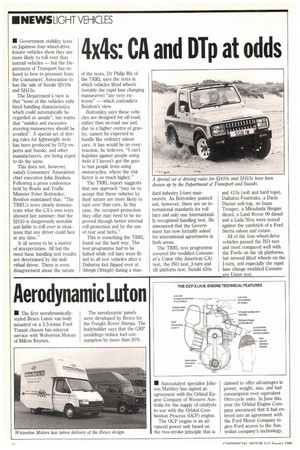4x4s: CA and Dip at odds
Page 22

If you've noticed an error in this article please click here to report it so we can fix it.
• Government stability tests on Japanese four-wheel-drive leisure vehicles show they are more likely to roll over than normal vehicles — but the Department of Transport has refused to bow to pressure from the Consumers' Association to ban the sale of Suzuki SJ410s and SJ413s.
The Department's view is that "none of the vehicles exhibited handling characteristics which could automatically be regarded as unsafe", but warns that "sudden and excessive steering manoeuvres should be avoided". A special set of driving rules for lightweight 4x4s has been produced by DTp experts and Suzuki, and other manufacturers, are being urged to do the same.
This does not, however, satisfy Consumers' Association chief executive John Beishon. Following a press conference held by Roads and Traffic Minister Peter Bottomley, Beishon maintained that: "The TRRL's tests clearly demonstrate what the CA's own tests showed last summer: that the SJ410 is dangerously unstable and liable to roll over in situations that any driver could face at any time."
It all seems to be a matter of interpretation. All but the most basic handling test results are determined by the individual driver. There is even disagreement about the nature of the tests. Dr Philip Bly of the TRRL says the tests in which vehicles lifted wheels (notably the rapid lane changing manoeuvre) "are very extreme" — which contradicts Beishon's view.
Bottomley says these vehicles are designed for off-road, rather than on-road use and, due to a higher centre of gravity, cannot be expected to handle like ordinary saloon cars. A ban would be an overreaction, he believes. "I can't legislate against people using 4x4s if I haven't got the guts to ban people from using motorcycles, where the risk factor is so much higher."
The TRRL report suggests that one approach "may be to accept that these vehicles by their nature are more likely to turn over than cars. In this case, the occupant protection they offer may need to be improved through better internal roll protection and by the use of rear seat belts."
This is something the TRRL found out the hard way. The test programme had to be halted while roll bars were fitted to all test vehicles after a Daihatsu 4x4 flipped over at 48mph (30mph) during a stan dard industry J-turn manoeuvre. As Bottomley pointed out, however, there are no international standards for roll bars and only one internationally recognized handling test. He announced that the Government has now formally asked for international agreements in both areas.
The TRRL test programme covered the modified Consumer's Union (the American CA) test, the ISO test, J-turn and tilt platform test. Suzuki 410s and 413s (soft and hard tops), Daihatsu Fourtraks, a Dacia Duster soft-top, an Isuzu Trooper, a Mitsubishi Shogun diesel, a Land Rover 90 diesel and a Lada Niva were tested against the yardstick of a Ford Sierra saloon and estate.
All of the four-wheel-drive vehicles passed the ISO test and most compared well with the Fords on the tilt platforms, but several lifted wheels on the J-turn, and especially the rapid lane change modified Consumers Union test.
















































































